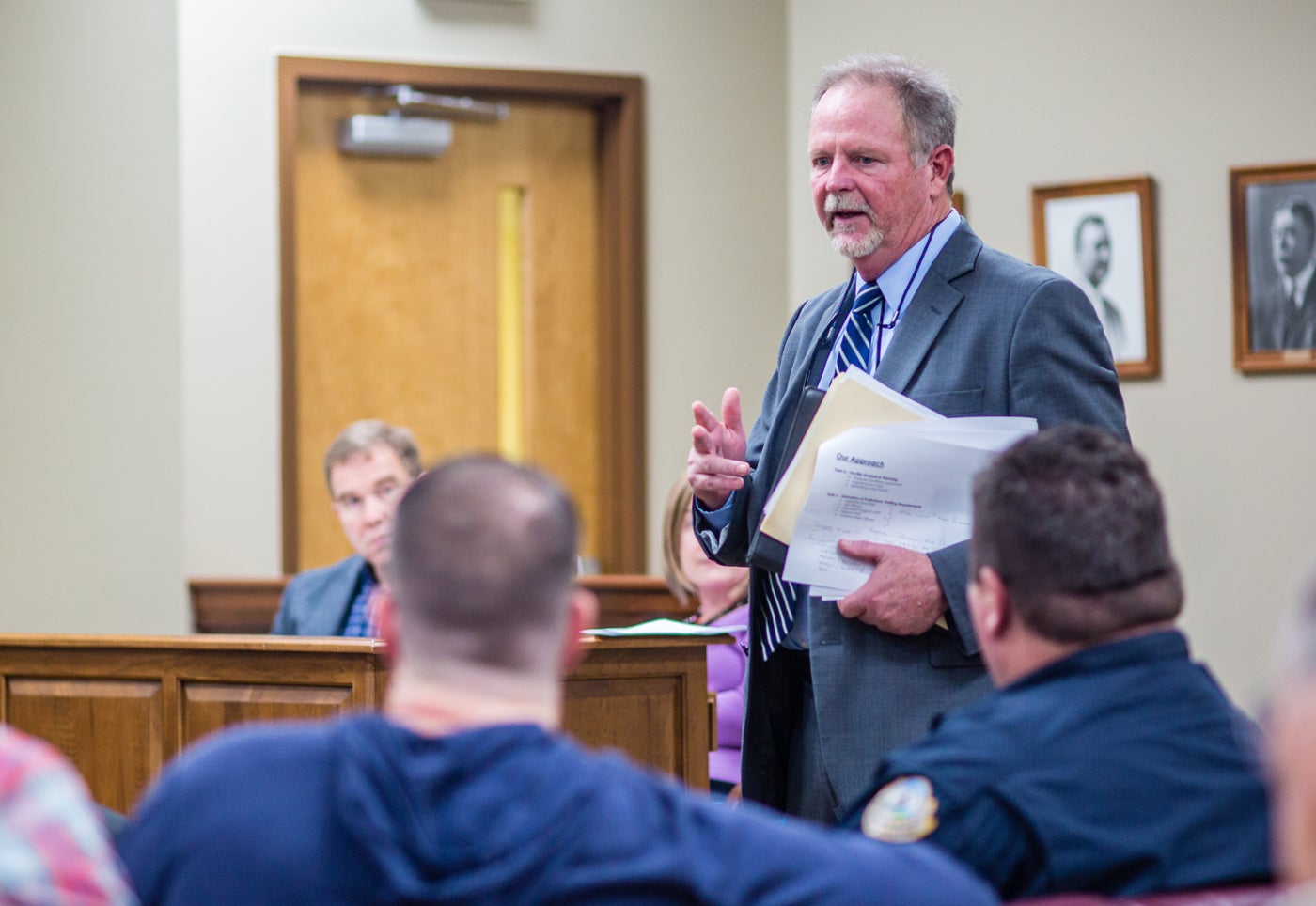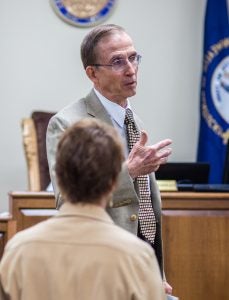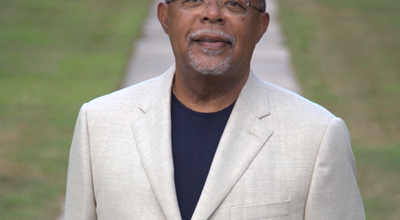Jail study will stay ‘down-to-earth,’ focus on action
Published 8:23 am Wednesday, November 8, 2017

- Ben Kleppinger/ben.kleppinger@amnews.com Dr. Kenneth Ray, a consultant with Brandstetter Carroll, speaks during Tuesday's Boyle Mercer Joint Jail Committee meeting.
Dr. Allen Beck is not a fan of statistical averages or “blue skies.” Both will only get in the way of accurate planning and taking appropriate actions when it comes to fixing the Boyle County Detention Center, Beck told members of the Boyle-Mercer Joint Jail Committee Tuesday.
Beck, one of a team of jail consultants from Brandstetter Carroll hired by the Joint Jail Committee, said in his decades of experience helping jails right their ships and shrink their populations, he’s seen many take the “blue skies” approach: They come up with a bunch of ideas for fixing things, choose the ones they like and anticipate great things happening — but nothing actually changes.
“We’re going to try to stay away from blue sky,” he said. “Let’s get down to earth.”
As for averages, Beck and his fellow consultant Dr. Kenneth Ray said too many jails — and many members of the public — can get caught up in misleading data and come away with the wrong ideas for how to solve jail problems. Jails might extrapolate from their existing population trends, for example, and determine they need a “mega-jail,” Ray offered. Members of the public might think building a jail capable of holding the average daily population of inmates is the correct move, Beck said.
What the averages all too often gloss over is what actions might reduce demand for jail cells, or how peaks and lows in population have to be accounted for, they said.
“When you’re thinking about building a jail, you have to think about the peaks that are going to happen,” Beck said. “But I’m interested in reducing the peaks, too.”
Tuesday’s presentation from Brandstetter Carroll was the first following the decision by Boyle and Mercer counties to hire the consulting firm at a cost of $75,000 to conduct an “inmate confinement and rehabilitation study.”
The study aims to inform the counties on how they can address skyrocketing jail costs and inmate overpopulation, whether through external programs, changes in incarceration policies, construction of new jail facilities, added rehabilitation efforts or all of the above.
Ray, who said he has run three jails and done assessments for around 30 more, was the bluntest about the likely need to jail fewer people.
“There are probably people in that jail that do not need to be in that jail. But for the philosophies and misunderstandings, sometimes just hard-headedness, of criminal justice players — and I see it every where I work … at some point, some of the change in your incarceration rates is going to require a change in how people view what a jail is for,” he said. “We used to believe that if we made jail hard enough — this was my thinking when I was a ’75 to ’86 police officer — if you make it hard, they’ll never come back. Really? OK, then why do we build the most prisons in the world? And why are the re-incarceration rates at 70 or 80 percent?
“There’s a problem with that. … We’re not looking at it from the offender’s view — what got them there.”
Ray said programs that reduce the number of people in the jail, like the Shepherd’s House Intensive Outpatient (IOP) program created this year, are “really important.”
Crime looks very different today than it did several decades ago, he said — “drugs have just painted the landscape with costs to the criminal justice system.” The Shepherd’s House program is an example of an “evidence-based approach to the root causes of incarceration” and exactly what the jail needs to be doing, he said.
Led by Beck and Ray, the five-member team from Brandstetter Carroll laid out what they expect to deliver to the Joint Jail Committee through the study:
• They will identify all the “key things driving the demand for jail beds,” and conduct numerous interviews to determine where problems are, Beck said. “Most of the people in the criminal justice system already know what the problems are,” he said. “… If I ask enough people — and I’m going to do a lot of interviews throughout the system — I’m going to find out most of those things. Then I use data to help me identify … what’s the size of the issues?”
• They will examine existing and previous jail programs to determine how effective they’re being and whether they could be improved upon. Jails can sometimes wind up with “million-dollar taxi cabs” — programs that could help but aren’t given enough funding and so they never get off the ground, Beck said.
• They will forecast what the needs of the jail will be in the future. This is a difficult task to get right and requires a lot of accurate data, as well as commitment from local officials to execute plans of action, Beck said.
• They will come up with specifics on the number of jail beds and facilities needed to serve the community, as well as what types of beds and facilities they should be — minimum security, maximum security, rehabilitation, etc.
• They will assess the current jail facility in terms of what it will cost to continue operating, and compare that cost to the potential cost of expansion and/or building a new facility.
• They will assess whether the jail currently has enough staff and what level of staffing would be needed in the future under different scenarios.

Ben Kleppinger/ben.kleppinger@amnews.com
Dr. Allen Beck talks about the jail study that consulting firm Brandstetter Carroll is conducting for Boyle and Mercer counties.
Ray and Beck touted their successes at three other jails around the nation, each of which is seeing a sustained reduction in its inmate population. At one jail, an “aggressive pre-trial release program” using ankle monitors helped relieve overcrowding, Ray said.
Releasing more prisoners could eventually become a requirement, Ray said, because the U.S. Department of Justice is currently litigating with different states it believes are using bail policies that discriminate against low-income people.
“They’re coming; it’s just a matter of time,” he warned.
Ray explained the reforms the DOJ is pushing for: “It’s a presumption of not guilty first, then a presumption that they don’t need to be in jail. Then, the court … has to prove that a person is a real risk.”
(Between 2012 and 2016, Boyle and Mercer counties offered defendants non-financial bonds to get out of jail at the lowest rates in the state, according to a report generated by the Administrative Office of the Courts this year.)
Beck said when Brandstetter Carroll finishes with its study, the final product will be a “living, breathing document” that Boyle and Mercer counties can continue using and updating into the future. It will include an executive summary, then units on each project the jail plans to undertake. The individual units will include appendices laying out how the jail can accomplish each project. And there will be progress assessments the jail can use to determine if it’s accomplishing what it set out to do.
“What you have is you have a document that doesn’t quit,” he said. “… It becomes something where you all as decision-makers will have (something) for your meetings that you can pull off the shelf and it’s a living document — you can see what’s going on. You don’t have to keep notes anywhere else; you can put them in here.”
MORE TOMORROW
The Boyle Mercer Joint Jail Committee is recommending the creation of a local Criminal Justice Coordinating Council to work on jail issues with help from Brandstetter Carroll. Read more about what that might look like in tomorrow’s Advocate-Messenger.






